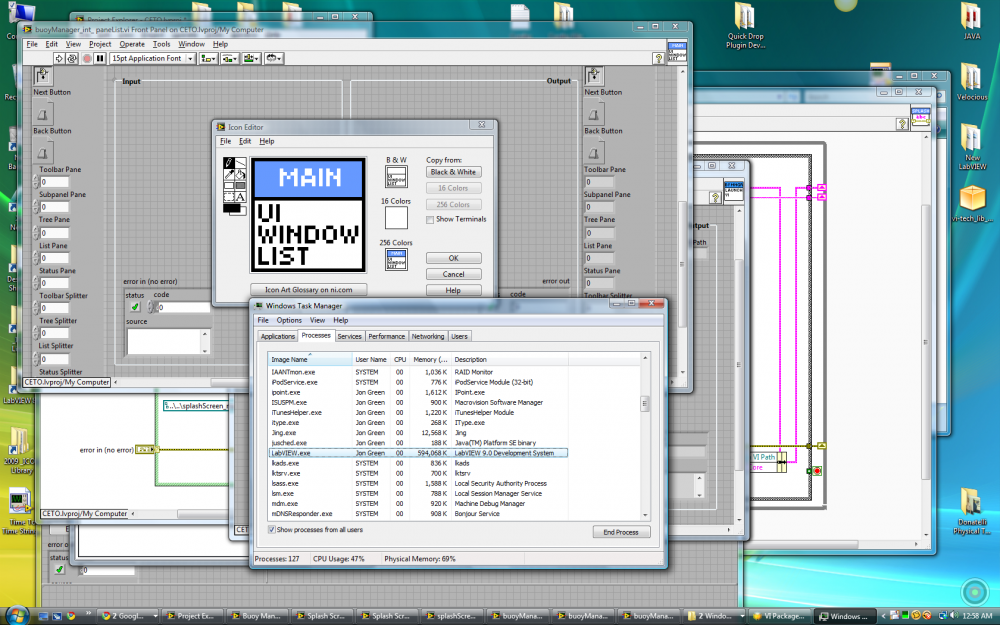-
Posts
2,397 -
Joined
-
Last visited
-
Days Won
66
Content Type
Profiles
Forums
Downloads
Gallery
Everything posted by jgcode
-
Use Excel for small-med projects. Evaluating FogBugz at the moment tho.
-
"I told them we already got one..."
-
Hi Crelf I have the Book/CD. It contains really cool methods of separating the UI and Engine. Do you prefer the Dynamic Events over the Queue method? Do you have any more good points that may have been developed since then with respect to this architecture? Cheers JG
-
Thanks for posting the link
-
Thanks Tomi and Daklu for replying to my questions. Tomi thanks heaps for the latest post, there is nothing I more then seeing the insides of a programmers brain - i.e. their code. And Daklu, no intential thread hijacking on my side - sorry mate!
-
Thanks for posting. I get what you are saying, and I guess my terminology sucks, or is confusing at least. But as I stated above its not really a constructor, its an initialiser. This is just something I did when trying to learn LVOOP. It's not easy/neat to construct an object that requires a lot of data. I end up having to use set methods then run the initialiser. By default I have always left this as Dynamic Dispatching, as I have found somethimes I want to override the behaviour of the initialiser for child objects. Is this wrong? I do not understand this, are you able to please clarify - if you wire in, or don't wire in a child object, won't your constructor still pass out the parent object regardless? If that is the constant on the block digram wire to the output terminal. Or is there something else going on under the hood I am missing? Cheers
-
Awesome work mate! Congrats
-
Cheers for the reply, I like to know what others are doing
-
What about reuse for the constructor* method? I find I regularly use dynamic dispatching (which requires input/output) in case the child method needs to call the parent on override or just needs to use it anyway. *This means it's not a true constructor (the LVOOP constant on the BD is really), and I even have to set some data before it sometimes, so it is really better suited to the term initialiser, but I prefer constructor. Then I have the problems above - that I can't force the constructor to be used (i.e. I might forget to use it in all cases!!) Trying to learn something too... I would love to be able to force a constructor/initialiser or something similar.
-
This is a great topic and I would love to hear everyones experiences with both toolkits. We get the UTF for free so price isn't an issue. I have been playing with the UTF a lot lately as well. Is someone from NI able to comment too? Keep this thread going...
-
http://zone.ni.com/devzone/cda/tut/p/id/8981 Our NI Wireless Sensor Network (WSN) Starter Kit just arrived today. Within an hour, I had it setup, the LabVIEW WSN Pioneer Module installed, devices communicating and was writing and deploying target VIs for the embedded modules. On first impressions this seems like a really neat product and is easy and kinda cool to use. The Kit contains two programmable nodes, the gateway, software and a few inputs (pot + thermocouples) I have just played with it on a PC but I am looking forward to connecting it up to a cRIO You can get a IP64 enclosure for them as well. Is anyone else using these? What are your thoughts?
-
I haven't tried the above, but I have noticed some strange things when building in 9.x. With source distributions, sometimes a control that is supposed to be included in an .llb destination, appears at the top level of the source distribution - outside of the .llb! I have to manually select that control to be in the correct destination folder, even though that virtual folder is set to go to the .llb
-
Nothing beats some good old complaining
-
Cool - you may be onto something!
-
On a side note there is also this LVOOP Constant Bug which I have witnessed. Unfortunately it has gone unanswered on NI's forums http://forums.ni.com/ni/board/message?board.id=170&message.id=439612&requireLogin=False
-
Thanks for the info however, I was just editing an icon in the LV09 Icon Editor and it made the switch to the LV8.x one. I was not playing around with the source code. I have been trying to bring it up from the LV09 Icon Editor again, but unsuccessfully
-
Are you able to please list the steps required to show the traditional editor. Cheers
-
Great topic. I was recently trolling through a 9.x project looking at these so that I could resolve the build spec paths into absolute paths. This was due to the new build feature in 9.x and how the paths are constructed and the issues associated with that. I wanted to add in 9.x support for my build script which would transparently build the Executable or Installer under e.g. C:/dist and then move all files back to the original location in the build spec to avoid any build errors. Due to the unknown constants in the build spec, I was not able to implement it as above. But I came up with a workaround that does the job. Would sure like to know what you find you tho. Cheers JG
-
I made the 8.x LabVIEW Icon Editor appear in LabVIEW 2009! It was by accident Has anyone done this? I can't seem to replicate it. Nonetheless it is interesting that it is still there. Cheers
-
Great legal comeback by the store: "If Jedi walk around our stores with their hoods on, they'll miss lots of special offers."
-
Well its not completely broken - its much better then the native version. I am happy to gave gotten the downloads form this topic, even if it is one.
-
I can see the difference in your post What version did you post in as I am getting this in LV09? (I even downloaded everything again just to make sure)
-
Ok, I misread your post
-
Sorry, to correct my grammer... I can see the difference between the native LabVIEW cluster and the three posted .ctls when I create arrays of these clusters. I cannot see any difference between each of the three posted .ctls when I create arrays of these clusters.




